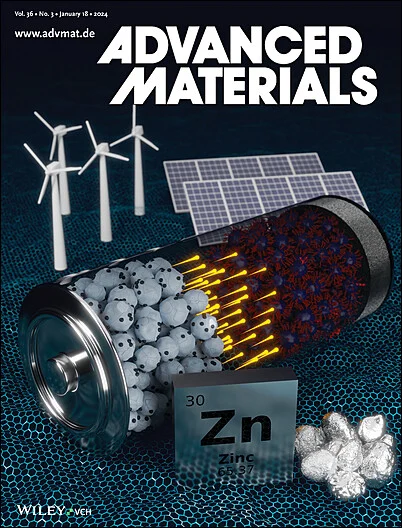变温x射线散射揭示了含碘电子受体的高效有机光伏的溶液聚集结构和加工弹性。
IF 26.8
1区 材料科学
Q1 CHEMISTRY, MULTIDISCIPLINARY
引用次数: 0
摘要
聚合物光伏电池有望成为低成本、灵活和轻便的电源。它们的性能很大程度上受到聚合物形态的影响:受体共混物,其中两种组分的聚集结构在电荷的产生、传输和整体器件性能中起着至关重要的作用。本研究利用变温小角度x射线散射和中子散射,探讨并解决了含碘电子受体BO-4I的高效聚合物光伏电池的溶液聚集行为和加工弹性。通过将BO-4I与氟化产物进行比较,发现BO-4I无论是在氯苯中还是在甲苯中都表现出优异的溶液处理稳定性。此外,温度引起的供体:受体共混聚集结构的变化导致薄膜形态的显著改变,最终影响器件性能。特别是BO-4I系统稳定的溶液聚合结构,赋予了设备性能处理弹性,实现了更高的设备长期稳定性。结合薄膜结构分析和器件性能表征,确定了从溶液到薄膜的结构继承,并确定溶液中有机光伏聚合物聚集体长度为27±3 nm是实现聚合物光伏电池最佳效率的关键特征。这些发现为设计未来的聚合物光伏系统提供了有价值的见解和指导。本文章由计算机程序翻译,如有差异,请以英文原文为准。
Variable-Temperature X-Ray Scattering Unveils the Solution Aggregation Structures and Processing Resiliency of High-Efficiency Organic Photovoltaics with Iodinated Electron Acceptors.
Polymer photovoltaics are promising for low-cost, flexible, and lightweight power supplies. Their performance is heavily influenced by the morphology of the polymer: acceptor blend, where the aggregation structures of both components play a crucial role in charge generation, transport, and overall device performance. This study probes and resolves the solution aggregation behavior and processing resilience of high-efficiency polymer photovoltaics incorporating an iodinated electron acceptor, BO-4I, using variable-temperature small-angle X-ray scattering and neutron scattering. By comparing BO-4I with its fluorinated counterpart, it is found that BO-4I exhibits excellent solution processing stability, whether in chlorobenzene or toluene. In addition, temperature-induced change in the donor:acceptor blend aggregation structure leads to significant alterations in film morphology, ultimately affecting device performance. Particularly, the stable solution aggregation structure of the BO-4I system confers processing resilience to device performance and achieves higher long-term device stability. Combining film structural analysis and device performance characterization, a structural inheritance is identified from solution to film, and determined that a organic photovoltaics polymer aggregate length of 27 ± 3 nm in solution is a key feature for achieving optimal efficiency in polymer photovoltaics. These findings provide valuable insights and guidance for designing future polymer photovoltaic systems.
求助全文
通过发布文献求助,成功后即可免费获取论文全文。
去求助
来源期刊

Advanced Materials
工程技术-材料科学:综合
CiteScore
43.00
自引率
4.10%
发文量
2182
审稿时长
2 months
期刊介绍:
Advanced Materials, one of the world's most prestigious journals and the foundation of the Advanced portfolio, is the home of choice for best-in-class materials science for more than 30 years. Following this fast-growing and interdisciplinary field, we are considering and publishing the most important discoveries on any and all materials from materials scientists, chemists, physicists, engineers as well as health and life scientists and bringing you the latest results and trends in modern materials-related research every week.
 求助内容:
求助内容: 应助结果提醒方式:
应助结果提醒方式:


